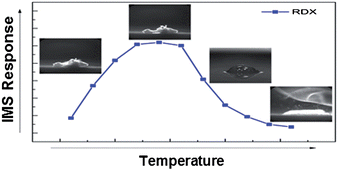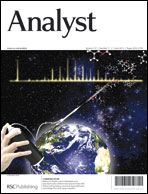Optimized thermal desorption for improved sensitivity in trace explosives detection by ion mobility spectrometry†
Abstract
In this work we evaluate the influence of thermal desorber temperature on the analytical response of a swipe-based thermal desorption ion mobility spectrometer (IMS) for detection of trace explosives. IMS response for several common high explosives ranging from 0.1 ng to 100 ng was measured over a thermal desorber temperature range from 60 °C to 280 °C. Most of the explosives examined demonstrated a well-defined maximum IMS signal response at a temperature slightly below the melting point. Optimal temperatures, giving the highest IMS peak intensity, were 80 °C for trinitrotoluene (TNT), 100 °C for pentaerythritol tetranitrate (PETN), 160 °C for cyclotrimethylenetrinitramine (RDX) and 200 °C for cyclotetramethylenetetranitramine (HMX). By modifying the desorber temperature, we were able to increase cumulative IMS signal by a factor of 5 for TNT and HMX, and by a factor of 10 for RDX and PETN. Similar signal enhancements were observed for the same compounds formulated as plastic-bonded explosives (Composition 4 (C-4), Detasheet, and Semtex). In addition, mixtures of the explosives exhibited similar enhancements in analyte peak intensities. The increases in sensitivity were obtained at the expense of increased analysis times of up to 20 seconds. A slow sample heating rate as well as slower vapor-phase analyte introduction rate caused by low-temperature desorption enhanced the analytical sensitivity of individual explosives, plastic-bonded explosives, and explosives mixtures by IMS. Several possible mechanisms that can affect IMS signal response were investigated such as thermal degradation of the analytes, ionization efficiency, competitive ionization from background, and aerosol emission.


 Please wait while we load your content...
Please wait while we load your content...